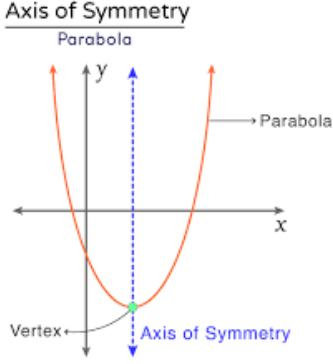How to Find the Axis of Symmetry of Quadratic Functions?
The axis of symmetry is a straight line that makes the shape of the object symmetrical. In this step-by-step guide, you learn more about the definition of the axis of symmetry and how to find the axis of symmetry of quadratic functions.

Related Topics
A step-by-step guide to finding the axis of symmetry of quadratic functions
The axis of symmetry is a straight line that makes the shape of the object symmetrical. The axis of symmetry creates precise reflections on each of its sides.
It can be horizontal, vertical, or lateral. If we fold and unfold an object along the axis of symmetry, its two sides are the same.
Axis of symmetry of a parabola
A parabola has one line of symmetry. The axis of symmetry is a straight line that divides a parabola into two symmetrical parts.
A parabola can be in four forms. It can be horizontal or vertical, facing left or right. The axis of symmetry determines the shape of the parabola.
- If the axis of symmetry is vertical, the parabola is vertical (opens up/down).
- If horizontal, the parabola is horizontal (opens left/right).

Note: The axis of symmetry, which is horizontal, has a zero slope, and the axis of symmetry, which is vertical, has an undefined slope.
Axis of symmetry equation
The vertex is the point that intersects the axis of parabola symmetry. This is the key to determining its equation.
If a parabola opens up or down, the axis of symmetry is vertical, and in this case, its equation is the vertical line that passes through its vertex.
If a parabola opens to the right or left, the axis of symmetry is horizontal and its equation is the horizontal line that passes through its vertex. That’s mean:
- The axis of symmetry of the parabola whose vertex is \((h, k)\) and opens up/down is \(x = h\).
- The axis of symmetry of the parabola whose vertex is \((h, k)\) and opens to the left/right is \(y = k\).
Axis of symmetry formula
The equation of the axis of symmetry can be shown when a parabola is in two forms:
Standard form:
The quadratic equation in standard form is, \(y = ax^2+ b x+c\), where \(a, b,\) and \(c\) are real numbers. Here, the axis of the symmetry formula is:
\(\color{blue}{x=-\frac{b}{2a}}\)
Vertex form:
The quadratic equation in vertex form is, \(y = a(x-h)^2+ k\), where \((h, k)\) is the vertex of the parabola. Here, the axis of the symmetry formula is:
\(\color{blue}{x = h}\)
Axis of Symmetry of Quadratic Functions – Example 1:
Find the axis of symmetry of the quadratic equation \(y=x^2-6x+2\).
Solution: Use this formula to find the axis of symmetry: \(x=-\frac{b}{2a}\)
\(x=-\frac{(-6)}{2(1)}\)
\(x=3\)
Related to This Article
More math articles
- How to Divide Polynomials?
- 4th Grade RISE Math Worksheets: FREE & Printable
- 5th Grade OAA Math Worksheets: FREE & Printable
- 3rd Grade MEAP Math Practice Test Questions
- 5th Grade WY-TOPP Math Worksheets: FREE & Printable
- Geometry Puzzle – Challenge 68
- 7th Grade ILEARN Math Worksheets: FREE & Printable
- 4th Grade PEAKS Math Worksheets: FREE & Printable
- 5th Grade FSA Math Practice Test Questions
- Geometry Puzzle – Challenge 72




















What people say about "How to Find the Axis of Symmetry of Quadratic Functions? - Effortless Math: We Help Students Learn to LOVE Mathematics"?
No one replied yet.